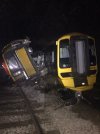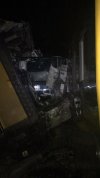AlbertBeale
Established Member
I hate to prick the bubble of this tree bashing festival but if you look at the photo posted a few posts earlier
Link https://www.flickr.com/photos/96859208@N07/10873585803
you can see from the photo that by the time the SWR train had passed under the road bridge and entered the now tree infested cutting with junction and tunnel entrance, it will already have passed the red signal in question.
The mile or so that the train would have been braking on, from roughly the A30 overbridge at Hampton Inn to the signal in question is mostly embankment/level ground level and, as a look at google maps shows, not greatly tree or bush infested.
The RAIB have stated that wheelslide is a factor, but have not stated it is the root cause.
There are also other mitigations available for wheelslide other than a chainsaw orgy (see the clasp brakes on Thameslink class 700s for an example).
Yes - looking at the cab video posted since this message, that [ie a lack of significant tree cover before the signal] seems to be the case. In that video, is the signal protecting Laverstock North junction also where the distant signal would be giving advance warning of the signal protecting the junction by the tunnel? [Excuse my ignorance.] If so, then presumably that yellow before Laverstock North junction would mean the driver was braking, from then at least, ready to be able to stop at the expected red before the tunnel.
From that cab video, it seems that the lineside vegetation between those two signals is largely isolated scrub and so on; the significant tree cover is only in the cutting by the junction just before the tunnel entrance - ie, after the signal where the train was due to stop. The pictures of the immediate area of the collision, together with the many comments on this thread about the need to cut down lots of trees, led me to believe that everyone making those comments knew (or at least assumed) that there was tree cover like that all the way back to where the train was due to be slowing down.
If that was the assumption, then it appears not to be an accurate assumption. I'd appreciate comments about this point from those who were calling for a lot of tree culling...
Last edited:



